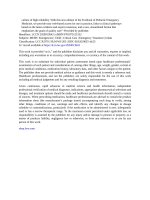Pediatric emergency medicine trisk 0822 0822
Bạn đang xem bản rút gọn của tài liệu. Xem và tải ngay bản đầy đủ của tài liệu tại đây (70.56 KB, 1 trang )
SDHs occur as a result of bleeding between the dura and the arachnoid
membranes covering the brain parenchyma. They may result from direct trauma
or from shaking injuries and are typically due to tearing of the cortical bridging
veins or due to bleeding from the cortex itself. SDHs may be bilateral, and
frequently, there is an associated underlying brain injury. Skull fractures occur in
only a minority of cases. Children with SDHs often have seizures, may present
with evidence of acutely elevated ICP, or may have more nonspecific signs of
vomiting, irritability, or low-grade fever. Physical examination often reveals an
irritable or lethargic child, with a bulging fontanel in infants, who may or may not
have neurologic abnormalities. CT scan commonly demonstrates crescent-shaped
subdural collections.
Intracerebral Hematoma
Posttraumatic intracerebral hematomas are unusual in children. Blood within the
parenchyma is usually the result of severe focal injury or penetrating trauma,
usually manifests with severe neurologic compromise, and often portends a poor
prognosis.
Subarachnoid Hemorrhage
Subarachnoid hemorrhage may occur following head trauma (including shaking
injuries in infants) and may cause headache, neck stiffness, and lethargy in the
child.
Diffuse Axonal Injury
Diffuse axonal injury is characterized by injury to the white matter tracts of the
brain and is one of the most common causes of prolonged posttraumatic coma in
children. The initial CT scan may be normal or may demonstrate multiple
petechial hemorrhages in the deep white matter and central structures. The degree
of microscopic injury is usually greater than that seen on CT imaging and MRI
may be more sensitive in accounting for clinical symptoms that are
disproportionate to (seemingly mild) CT-scan findings.
Cerebral Edema
Diffuse cerebral edema occurs frequently in children with severe head trauma. It
appears to be a reactive phenomenon that occurs within hours of the traumatic
event and is likely a final common manifestation of brain injury caused by a
variety of pathophysiologic processes. The major effect of this swelling is
potential for significant elevation of ICP. These children have a depressed level of
consciousness and may have focal neurologic signs or symptoms of herniation.









